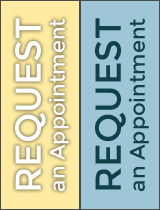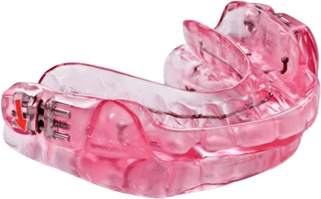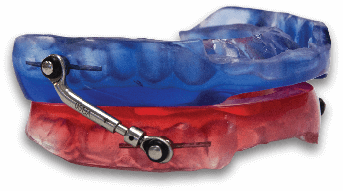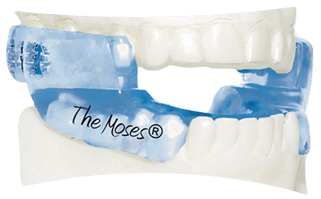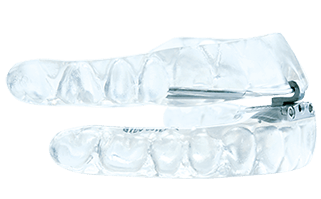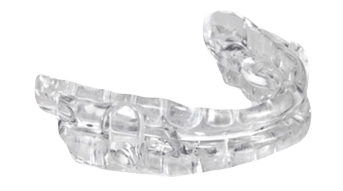Treating Sleep Apnea with Oral Appliances
Here at Weatherford Dental Sleep Medicine, Dr. Deborah Romack and her team are dedicated to helping you discover whether or not you suffer from obstructive sleep apnea (OSA) with the help of advanced technology and skilled assistants, but once we’ve formed a concrete diagnosis with your regular physician, what’s the next step? It’s time to find the right treatment that provides relief from symptoms and helps you rest easy throughout the night. In most cases of mild to moderate sleep apnea, the condition can be treated with a customized oral appliance.
An oral appliance from our Weatherford, TX office may not seem significant, but it repositions the lower jaw and tongue dramatically reducing the chances of airway blockage during sleep and virtually eliminating snoring and other symptoms of sleep apnea. Oral appliances are especially encouraged for patients who’ve experienced CPAP failure. If you've found that particular treatment option dissatisfying, Dr. Romack offers combined therapy for more complicated cases.
Today, most dental plans cover the cost of oral appliances, and our team works directly with your insurance thanks to our advanced medical and billing software.
Different Types of Oral Sleep Appliances
There are nearly 100 different variations of appliances available and we're happy to offer several of them, including:
Dorsal Appliance
The Dorsal appliance is one of the most popular choices today for treating chronic snoring and sleep apnea due to its comfort and convenience. The device is composed of two pieces allowing patients to move their jaw, talk, or even yawn without difficulty while holding the mandible in a specific, positive position. In fact, patients will be surprised by how much it looks like a regular mouthguard.
Herbst Appliance
The Herbst appliance has been used for years in conjunction with TMJ therapy and orthodontic treatment, but only fairly recently have doctors realized it can be beneficial to patients suffering from sleep apnea. Its greatest advantage is the adjustability. Patients can move their jaw laterally and vertically without causing problems, and if the initial position doesn’t provide relief, it can be changed.
Moses Appliance
The two-part design of the Moses appliance offers patients various benefits including lowering uncomfortable muscle activity, increasing the amount of space in the mouth for your tongue, and reducing bruxism (teeth grinding/clenching). Better yet, patients can close their lips, talk, and drink water while wearing it.
dreamTAP
The Thornton Adjustable Positioner (TAP) appliances are well established as offering effective sleep apnea therapy for many patients. Their newest sleep apnea appliance is called the dreamTAP, and it speaks to one of the main complaints wearers have about other sleep apnea appliances. Many of the traditional occlusal splints crafted to shift the jaw forward keeping the airway clear also reduce the space in the mouth for the tongue. This can trigger gag reflex. The dreamTAP appliance has significantly more tongue space, making it the most comfortable oral appliance available to date.
ProSomnus® Sleep and Snore Devices
ProSomnus appliances are some of the smallest and most comfortable custom-made devices in sleep dentistry today! They’re painstakingly personalized with modern CAD/CAM technology in order to be an ideal fit for each patient’s mouth. Their two-part structure also provides plenty of space within the mouth so that the tongue can rest comfortably while you’re asleep (no unpleasant mouth breathing) and allows for wearers to open and close their mouth flexibly.
Benefits of Oral Sleep Appliances
Dr. Romack determines the best oral appliance for your unique case taking into account the severity of sleep apnea and any preferences and/or concerns you may have. No matter what device you end up wearing, all oral appliances provide patients with benefits compared to other treatment solutions like CPAP and surgical interventions. These benefits include:
Ease of Use
With an oral appliance, sleep apnea patients don't have to worry about using a big, bulky machine that makes loud noises or attachments that make sleeping uncomfortable. Just pop the appliance into your mouth, and you're ready for a great night of sleep.
Portability
Many people who suffer from sleep apnea elect not to bring their CPAP machine on trips because it's just too much hassle. Your oral appliance is much more lightweight and compact allowing you to carry out the same sleep routine wherever you are.
Comfort
Your oral appliance is personalized to fit your unique smile, and most patients get used to wearing it after only a couple of weeks.
Effectiveness
After wearing their oral appliance, most patients report a significant reduction in sleep apnea symptoms, especially if they primarily sleep on their stomach or back.
Affordability
The average cost of a custom oral appliance is usually less than a CPAP machine.
As a proud member of the American Academy of Dental Sleep Medicine (AADSM), Dr. Romack is happy to follow the standards they’ve set for dentists who treat sleep apnea with oral appliance therapy. These include:
- Doctors need to prescribe oral appliances over no therapy for patients who suffer from snoring and not obstructive sleep apnea.
- When an oral appliance is recommended for cases of obstructive sleep apnea, the doctor needs to rely on custom appliances over those that are non-custom.
- Patients who are intolerant of CPAP therapy need to receive a prescription for an oral appliance instead of no treatment at all.
- Patients with obstructive sleep apnea also need to receive screening for any dental-related side effects from their doctor instead of no follow-up.
- Doctors need to confirm the effectiveness of treatment or recognize room for improvement with the help of follow-up sleep testing instead of follow-up with no sleep testing for patients who are using oral appliances to treat sleep apnea.
- Doctors need to instruct obstructive sleep apnea patients to return regularly to their office for follow-ups.
